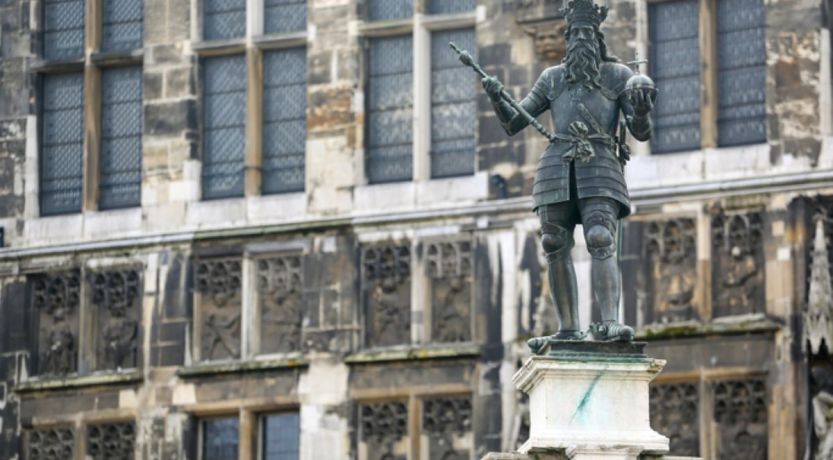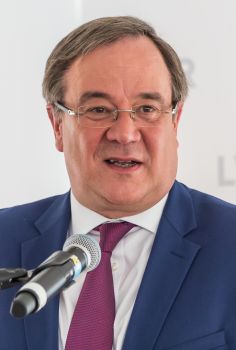Charlemagne’s Long Shadow on Europe Today
Charlemagne is known as the greatest emperor since the fall of the Roman Empire. What effect does his legacy have on Europe today?

A monument to Charlemagne that stands in Aachen, Germany.
Angela Merkel has had an incredible career. She is expected to narrowly surpass Helmut Kohl as Germany’s longest-serving postwar leader—he served for 16 years 27 days. Their combined leadership over Germany will total 32 years! That’s almost half of the time from the end of World War II until today.
Germany has had only nine postwar leaders, compared to Italy’s 30 or so (averaging around 2½ years per leader). This explains why Germany is known for stability, and Italy for instability. Also, it has contributed to Germany’s becoming the biggest economy in Europe.
So all eyes are on the person who will replace Angela Merkel. Her party, the Christian Democratic Union (CDU), recently selected its new leader: Armin Laschet. He will lead the CDU in Germany’s September 2021 elections and is the likely heir to Mrs. Merkel. Before entering politics, he graduated with a degree in law and edited a Catholic newspaper. Mr. Laschet has also worked on healing the rift between the Vatican and the German church and has met with Pope Francis.
He was born in Aachen, famous for being the favorite residence and the resting place of Charlemagne. Interestingly, Mr. Laschet claims to be a descendent of Charlemagne, and he greatly admires the former emperor. Charlemagne, the king of the Franks, is famous for uniting Europe under the banner of the Holy Roman Empire.
Armin Laschet
Holy Roman Emperor Charlemagne
Charlemagne, known also as Charles the Great, is seen by many as the father of Europe and Western civilization. He ruled over a territory that includes much of modern-day Europe—France and most of Germany, Belgium, Italy, Luxembourg, the Netherlands, Switzerland, and parts of Austria, Croatia and Slovenia.
Charlemagne believed it was his duty to advance and enforce Christianity within his empire through forced conversions. In essence, conquered people had to convert to Catholic Christianity or die.
Charlemagne ruled during a time when the papacy was vulnerable. However, the pope found a protector in Charlemagne. He waged war on and defeated the Lombards, who opposed the papacy. In return for Charlemagne’s devout support, in 800 Pope Leo crowned him the emperor of the Romans, forming the Holy Roman Empire. This gave Charlemagne’s empire greater legitimacy and increased the pope’s stature as the one who granted temporal power.
Over a period of three decades, Charlemagne waged a series of ruthless holy wars against the Germanic tribes. He continued his practice of conquering a people and “converting” them to Christianity. One of his most notorious acts is known as the massacre of Verden, where he killed around 4,500 Saxons and eventually forced the Saxons to convert to Christianity.
Charlemagne’s legacy
Today, Europe doesn’t focus on Charlemagne’s ruthlessness in promoting peace and Christianity through the sword. Instead, Europeans remember him as the man who united Europe under a common culture.
His legacy continues to this day. Every year since 1950, Europe has given the International Charlemagne Prize of the City of Aachen to an individual who has done the most to promote the cause of European peace and unity. The award is presented in Aachen, the city where Charlemagne is entombed, and is seen as one of the greatest awards a European can receive.
In 1952 Europe started to come together after the warfare of World War II, when six nations formed the European Coal and Steel Community (Belgium, France, Germany, Italy, Luxembourg and the Netherlands). This union grew into the current European Union, now consisting of 27 nations.
Europeans remember Charlemagne as the man who united Europe under a common culture.
One of the pioneers of the early union of European nations was Richard Nikolaus Eijiro of Austria. He received the first Charlemagne Prize in 1950.
In his acceptance speech he dubbed the early union as “Union Charlemagne” and described it as “the renewal of the Empire of Charlemagne as a confederacy of free nations.” Continuing, he said, “Today this Charlemagne movement should stem from Aachen in the memory of that German-French emperor, to transform Europe from a battlefield of recurring world wars to a peaceful and blooming worldly empire of free people!”
Charlemagne also served as a source of inspiration for Napoleon Bonaparte (1769-1821) and Adolf Hitler (1889-1945), both of whom attempted to unite Europe by force.
Interestingly, both the French and the Germans claim Charlemagne as their own. In 1809 Napoleon famously said to the pope’s envoys: “In me you see Charlemagne. I am Charlemagne, me!”
Hitler was also a big admirer of Charlemagne. He labeled his rule as the Third Reich (German for “empire”)—with Charlemagne’s Holy Roman Empire being the First Reich.
Church and state
One key feature of the Holy Roman Empire was the union between church and state. As Charlemagne was crowned by the pope, so, too, were future emperors who came under the authority of the popes. In exchange for the recognition of the papacy, which helped provide legitimacy, the emperor often protected the power of the papacy and the assets of the Catholic Church in Europe.
Examples of this abound in European history.
Napoleon used the Catholic Church for his own benefit. Though he signed the Concordat of 1801 with Pope Pius VII, bringing the Catholic faith back into France as the “majority faith,” he saw religion as a tool for controlling the people. He is quoted as saying: “Religion is excellent stuff for keeping common people quiet. Religion is what keeps the poor from murdering the rich.” In 1809 Napoleon invaded the Papal States and arrested Pope Pius VII for refusing to execute his demands.
In 1929 Benito Mussolini signed the Lateran Treaty with the papacy, recognizing Vatican City as an independent sovereign state in return for the pope’s recognition of Mussolini’s right to rule Italy. In 1933 Hitler’s Germany also signed a concordat with the papacy.
To learn more about how this history connects with prophecy, read our articles “Who Is the Beast?” and “What Is Babylon?”
A future alliance of church and state
The two systems of politics and religion are pictured as two beasts in Revelation 13. The first beast, “rising up out of the sea” (verse 1), represents a political power—a revived Roman Empire. This political power will lead “ten kings” (Revelation 17:12). These kings represent European nations, or groups of nations, that will unite under one charismatic ruler.
The second beast is pictured as one “coming up out of the earth” (verse 11) and is a religious power. It’s described as looking like a lamb, but speaking like a dragon. This means that it has an outward appearance of Christianity, but speaks the words of Satan. In the end time, this religious leader will perform great miracles to deceive the entire earth (verses 13-15; compare 2 Thessalonians 2:9-10).
This political and religious alliance will control the world’s economic system and enforce adherence to its economic authority (Revelation 13:17; compare 18:11-13).
Yet this relationship is described as “fornication” (Revelation 17:2). This means that the political and religious powers will use each other for their own selfish needs. This unstable relationship will lead to its demise (Revelation 17:16). The beast power will ultimately make war against the returning Jesus Christ and be destroyed by Christ Himself (verses 12-14).
Continue watching Europe. Watch for ongoing efforts to unify Europe and make it a greater political force on the world scene, and for the growing influence of the Roman Catholic Church in European politics.
Photo credits:
Jacek_Sopotnicki/iStock via Getty Images
Photo of Armin Laschet: Raimond Spekking / CC BY-SA 4.0
Date Posted: March 2, 2021



